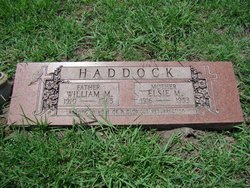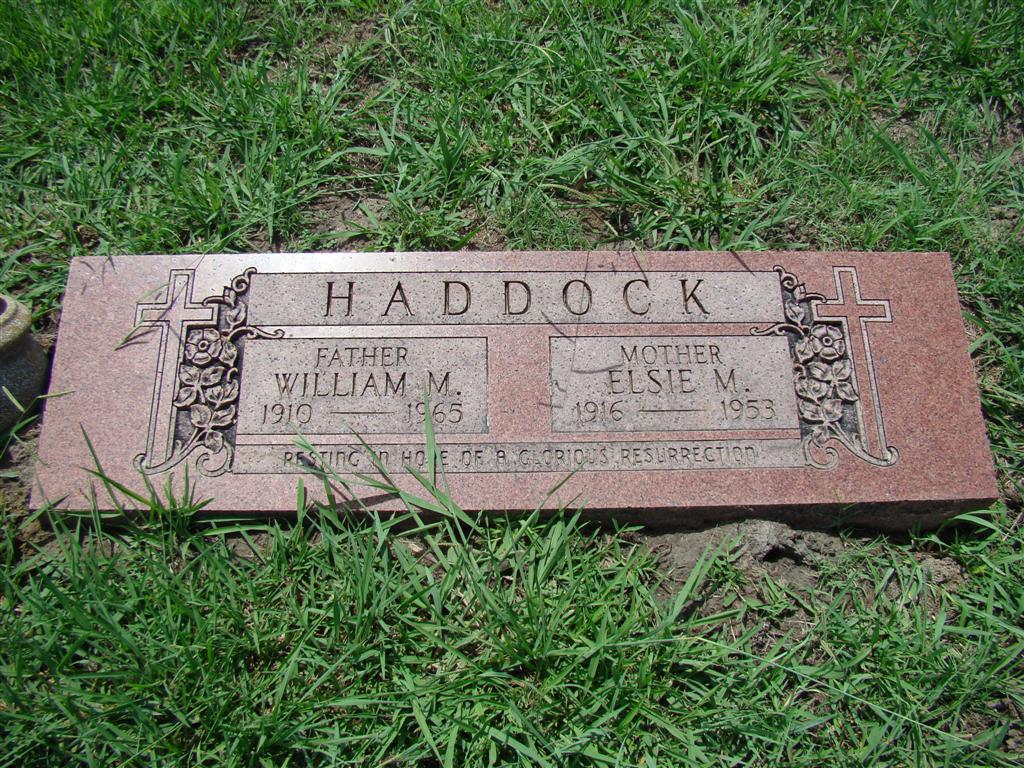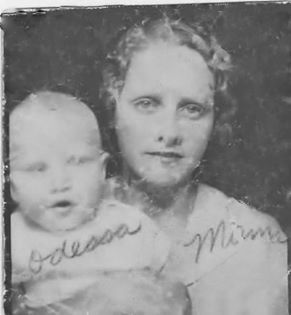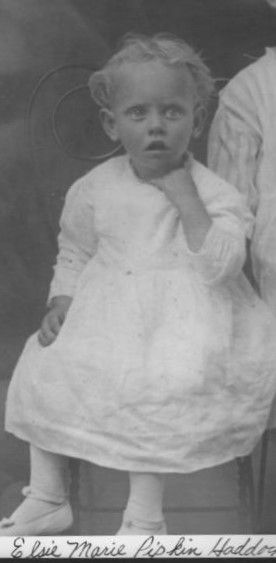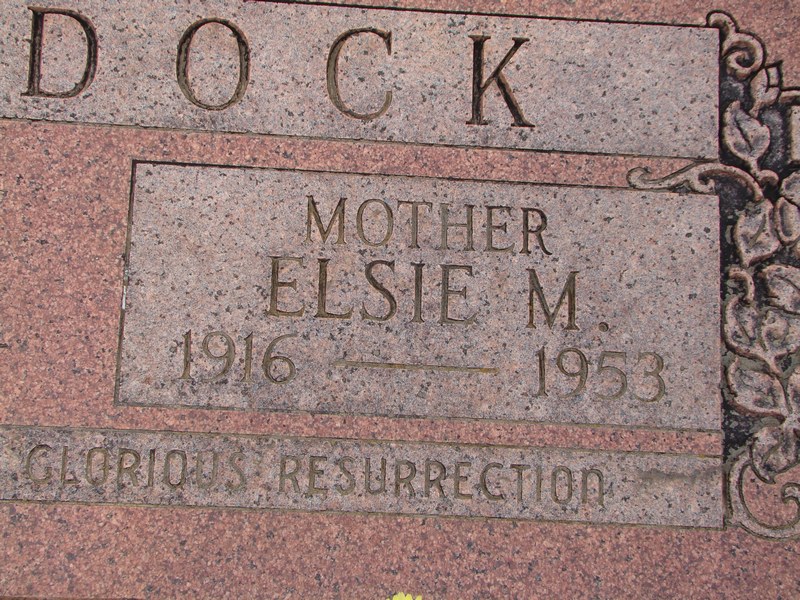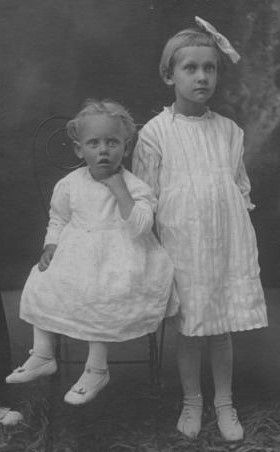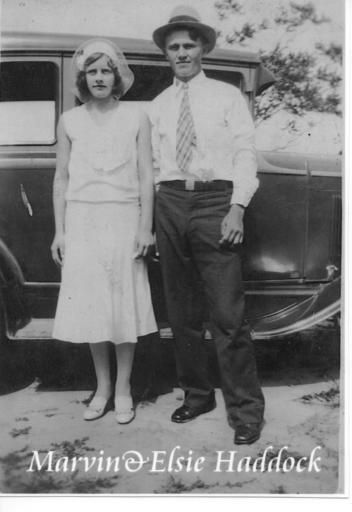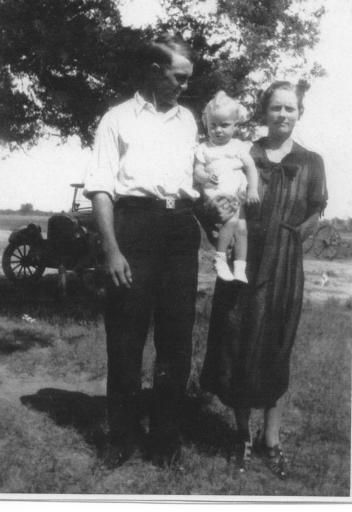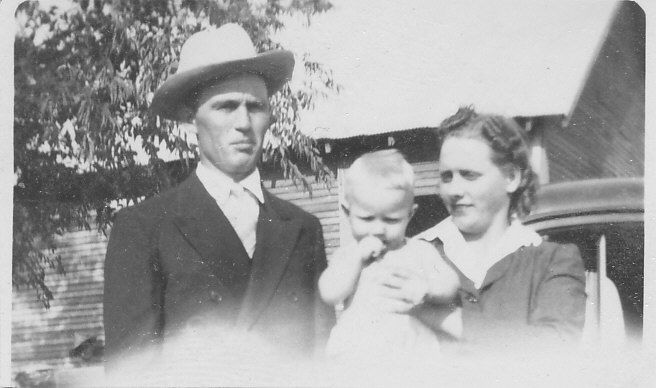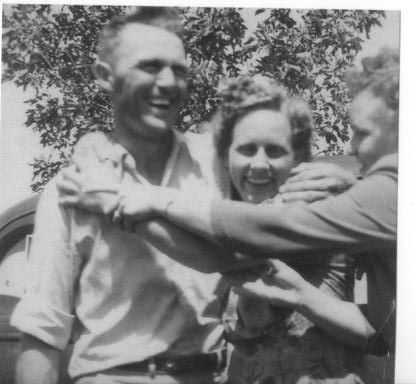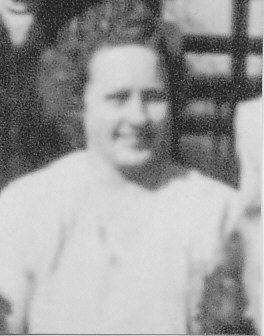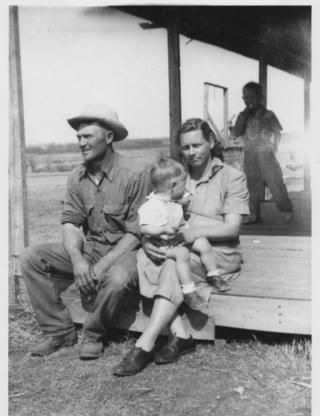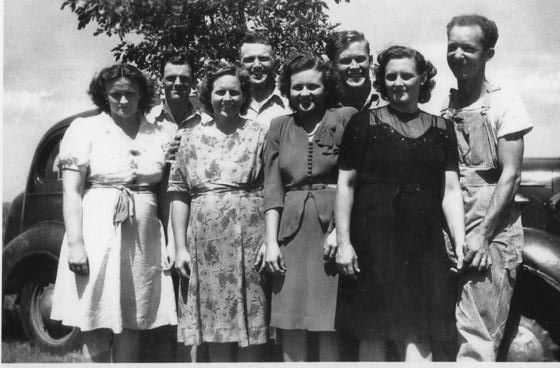Last rites were held Saturday, May 30th, for Mrs. W.M. Haddock, 37, of Route One, Cumby, TX, who passed away at 5:15 A.M. May 29th, in a Commerce Hospital.
Mrs. Haddock was born April 6, 1916 in Hopkins County, the daughter of Grover Alton and Belva Mae FLEENOR Pipkin. She was a member of Rea's Chapel Methodist Church in Branom Community.
Survivors of Mrs. Haddock are her husband and seven children: Odessa Faye, Maredia Maye, Marvin Clifton, Nolan Oneal, Billy Dan, William Alton, and Gary David; her parents, Mr. and Mrs. Grover A. Pipkin of Miller Grove; six sisters, Lynna Willis of Cooper, Esther Roberson of Vernon, Adeline Garner, Wanda Wise, and Bernice Long, all of Lubbock; and Ava Brunson of Garland. She is also survived by two brothers, Grover A. Pipkin Jr. of Dallas, and Buford L. Pipkin of the U.S. Navy.
Services were held in the Mt. Zion Church at 3:30 P.M. Saturday May 30th with Revs. John Dowd and McClung officiating. Interment was in Mt. Zion Cemetery with Jones Funeral Directors in charge.
Mother was a kind, caring, considerate, honest and hard-working person. She had a beautiful smile. She loved her husband, her children, her family and extended family. They married November 5,1932 in Hopkins County, TX. Eight children were born to this union. When GOD picks a flower he takes the best. She is resting in the hope of a glorious resurrection.
A MOTHER'S DAY MEMORY: Elsie Marie Pipkin Haddock-by her son, Billy.
When ELSIE MARIE PIPKIN was born on April 6, 1916, in western Hopkins County (near Ridgeway), Texas, her father, Grover Alton, called Mr. Pip, was 23, and her mother, Belva, nicknamed Betty, was 23. She was the second born of 10 children. Pictured is Elsie and her older sister, Lynna, taken in 1919.
[See slide show at the end of this article]
The Spanish flu, an unusually deadly influenza pandemic had not begun when she was born. Lasting from January 1918 to December 1920, it was suspected having spread from soldiers returning from World War I on passenger ships. Eventually, it infected 500 million people—about a quarter of the world's population, at the time, and struck families in that part of the county as well. Now, about 100 years later, the world is dealing with another pandemic: the corona-19 virus.
Elsie married William Marvin Haddock on November 5, 1932. They had eight children while married. All but one lived to adulthood.
They lived in western Hopkins County near Ridgeway and Marvin Haddock lived in Hunt County, near Commerce. They were connected by the railroad and a dirt road that roughly paralleled the railroad that would become state highway 11. It's unclear how they met. Either way, they formed a loving relationship and married, as people who loved each other and wanted to share a life together did in those days. She was a member of the Baptist church, her parent's religious preference, and after they married she joined the Rea's Chapel Methodist church, Marvin's preference, in the Branom Community[1].
Marriage
ELSIE was 16 years old. Marvin, who was 22, was, like Elsie, from a sharecropper family, meaning they were tenant farmers who gave a part of each crop as rent. They would live in at least 12 or 13 different places and houses during her short life, many without electricity or indoor plumbing.
Less than a year after marriage, working class and rural Americans were tightly in the grip of the Great Depression. Forty percent of the nation's banks failed between 1929 and 1933, and almost 4-million manufacturing jobs were lost as consumption and production became locked in a downward spiral. The first "New Deal" created by President Franklin Roosevelt and his cabinet was aimed at providing relief and recovery to those hit hardest by the depressed economy.
A farmer wrote in her diary in 1933 about the impact of the "New Deal" in rural areas:
"Well, the national farm strike … set for May 13 has been postponed, for which we are all thankful. They came to that decision after Roosevelt signed the farm bill, which makes it possible for the loan companies to refinance mortgages. … Well, it gives us more courage to go on. We had about given up ever trying to keep up anymore. [2]"
It took courage just living from day to day during those times and Elsie lived through the stress of the great depression and World War II.
Elsie's Children
Her daughter Odessa Faye was born on Thursday, October 31, 1935, delivered around 1:00 am in Commerce, Hunt County, Texas even though they lived near Klondike in Delta County. Apparently, they lived on this place for a few years since her next her daughter Maredia Maye Haddock was born on January 27, 1939, in Cooper, Delta County, Texas.
The 1940 Census shows them still living there on April 1, 1940. Her son William Walter was born there on November 28, 1940 and passed away that same day. While living there Elsie's husband, Marvin, registered for the draft as ordered.
By 1941, they had moved near Miller Grove, Texas in Hopkins County, and were living down the road from Elsie's parents when the United States declared war on Japan just one day after the attack on Pearl Harbor that killed 2,400 Americans.
"…, December 7, 1941, a date which will live in infamy," declared President Franklin D. Roosevelt before Congress, "the United States of America was suddenly and deliberately attacked by naval and air forces of the Empire of Japan."
The surprise assault on Pearl Harbor, which killed 2,400 American servicemen and civilians, made Americans and their political leaders resolute. After two years of isolationism, the United States declared war on Japan and entered World War II. Fearing that the country's entry into the global conflict was inevitable, Roosevelt had launched the first peacetime military draft in U.S. history starting in September of 1940.
Marvin registered for the draft but was exempt from military service since farming was considered an essential occupation. If he had served in the military and survived; Elsie probably would not have had her next two children when she did (during the war years).
Her son, Marvin Clifton, was born at their home on Friday, January 22, 1943, at 11:30pm.
In the fall of 1943, they moved to the Paris, Texas area in Lamar County along with families of parents on both sides. Daughter, Maredia remembers the house they lived in: "We lived in a large, unpainted house with a huge attic area (a fun place to play) at Petty.[3]"
Son, Nolan Oneal, was born there on Monday, July 24,1944 at 7am, in Petty, Texas.
Her son, Billy Dan, was born at home on Friday, August 13,1948 at 11:45am, in Hopkins County, Texas. Marvin's sister, Juanita Haddock Gunter, often served as the midwife in the absence of a physician. "She was a bleeder," Juanita was overheard saying, referring to Elsie's tendency to experience bleeding after delivery [4].
The house was on land in Branom that Marvin had bought (with a mortgage) from his mother's people, the Raines family, and had to sell after a crop failure.
Her son William Alton was born on Friday, April 17, 1950, in Commerce, Texas.
Her son Gary David Haddock was born on May 29, 1953 at 2:30am, in Dr. Louis Seyler's Clinic, Commerce, Texas, shortly before her death.
Death
ELSIE MARIE PIPKIN died on May 29, 1953 at 3:30 am, when she was 37 years old. Her death certificate listed the cause of death as post-partum hemorrhage. Reportedly, she had been cautioned about having more children previously since she had a tendency for her uterus to collapse during birthing.
Burial
Elsie was laid to rest in the Northeast section of Mount Zion Cemetery, Hopkins County, Texas, USA, Row 2, gravesite 15. On her tombstone is the following inscription: "Resting in hope of a glorious resurrection." Seems appropriate as this is penned on Easter weekend 2020 during the shelter in place order of the coronavirus pandemic.
Commentary:
Our immediate family spent 37 years talking very little about our mother, Elsie. Consequently, many of her younger children, knew very little about her because of their youth and were grief stricken after she died. Therefore, an effort was made later to gather the lost information about her.
Besides acting as nurse for the family, relying on home remedies of the day, Elsie was a very good seamstress and often made clothes for the children from materials re-purposed from flour sacks. Back then the flour came in pretty fifty-pound, floral cotton sacks. She bought a lot of it because farm people rarely could afford loaf bread.
Elsie also acted as disciplinarian. She had put herself in charge of disciplining only the girls after Marvin whipped Odessa with a razor strap. According to daughter, Maredia, she got her share of whippings from Elsie with a tree limb or cotton stalk.
As manager of the household, Elsie canned mincemeat, a finely chopped mixture of raisins, apples, spices, and other ingredients with or without meat for holiday occasions. She also canned chickens, vegetables from the garden and fruit, picked up pecans and worked in the fields alongside Marvin. This was the custom for rural Americans in those days.
Gone but not forgotten
In 1991, this writer published the first edition of the Haddock family history. As part of that effort supported by my sisters, we canvassed living relatives for information related to what Elsie was like. Below is a composite of those remarks that were collected:
Most agree the features that stood out about Elsie were her soft blue eyes, her blonde hair and her fair complexion. Her favorite colors were blue and pink. A pink chiffon dress and a medium blue suit, which she made herself, were among her favorite clothes.
The words that were most often used to describe Elsie's personality were: kind and gentle, perhaps gentle as a lamb. She was also described as "easy-going and real tender-hearted," especially toward animals. She always liked to pet the dogs, cats and even cows and horses. In addition, she kept chickens. Her disposition and kindness always stood out. She was very patient and seldom fussy. She tended to be quiet, had a good sense of humor and smiled a lot. She was a good mother, wife, sister and friend.
Elsie apparently enjoyed eating. Consequently, she was remembered for having been a good cook. Among the favorites from her kitchen that were mentioned were biscuits, yeast rolls, syrup cake, and tea cookies. She also did a lot of canning, as was the custom of that time, and always had lots of canned food from the garden. She was known for growing a good garden that included vegetables and flowers, such as zinnias, marigolds, sweet Williams, petunias, bachelor buttons, and sweet peas. She also had a lot of houseplants.
She showed an early talent at helping with the younger children. She seemed to have a knack of getting them to do what she wanted. In addition, she showed a lot of common sense in raising her own children. If she and her husband, Marvin, had trouble, she wouldn't fuss back at him. She would go someplace and cry. Although not known to have a nickname, apparently, Marvin had a pet name for her, or teased her in some way that made her blush.
Elsie never held a public job, but the job as a farmer's wife was an all-encompassing lifestyle. She spent what Marvin gave her, even if the family worked together in the cotton fields. They decided together how the money would be spent. She learned to be a good manager and could make money go a long way. Many times, the family had only a limited amount of food or clothes, but they never went hungry or dirty. She embroidered, quilted some and made most of our clothes to assist in this effort.
Elsie was religious all her life. She was saved at an early age and much of her dating with daddy was centered around church services. Although they didn't travel much, she enjoyed visiting her parents, relatives, and their few close friends.
From the Pipkin family (of English origin), Elsie probably inherited a tendency toward skin cancer due to their fair complexion. From the Fleenor family (of German origin) she may have inherited a predisposition toward diabetes and high blood pressure. She developed asthma the last couple of years of her life and couldn't always breathe when she would first lay down at night.
Her youngest sister, Ava, shares the following account of the impact of mother's death on her life:
"I remember the morning we got the call she had died. I just could not believe it had happened. Up to that time I had never been saved. After that happened, the Lord spoke to me and made me realize that this could happen to any one of us and that we needed to be prepared to die. For a long time, it was hard for me to accept what happened to her. But, later, I realized that God has a plan for all of us. We just never know when or how."
Regardless of the circumstances, we are challenged to honor the role of all people and circumstances in this event and look toward the advantages. In a good life it helps to bring honor to the family name. Our ancestors and descendants can teach us important lessons. True honor comes from humbly allowing God to work through our lives in difficult situations.
Only a spiritual viewpoint offers this honor. If we choose to see this and other tragic events as designed by God for our spiritual growth and development, then we must conclude that God honored Elsie beyond our comprehension. If this is so, then we have no choice other than to love and honor all persons involved. Only by shifting our views regarding (Elsie's) death, can we prepare to fully receive God's gifts for us.
Many of her children were reminded of flowers when thinking of Elsie. For example, someone else said (when speaking of Elsie's death), "when God picks a flower, He picks the best one." The complexities of love and loss are often represented in the symbolic language of flowers. No one is ever prepared for the loss of a loved one. However, people who do the work of grief do begin to heal with time and learn that even the worst losses can burst into bloom. There comes a time in life when we must all bloom where we are planted. There comes, at a proper time in the life cycle, a bloom, regardless of height, growth, soil conditions, nutrients, or trauma to the plant. These all affect the height of the plant and quality of the bloom, but the bloom comes anyway. It is a life force that will manifest itself.
Whether these stories, meanings or images reflect the true picture of Elsie is not as important as how we use these associations to affect the ways in which we live our lives. A flower which does not open cannot receive what is needed to contribute to its continuing growth and life. It seems we must be taught to open up more and learn from each other. Flowers can bloom in her name through the lives of all her descendants who choose to strive to become their "higher selves" and dedicate their lives to love, peace and gentleness[5].
(Scroll to the bottom for pictures.)
Primary Sources:
Bittersweet Memories: MEMOIRS OF A SHARECROPPER'S DAUGHTER, Maredia Haddock Cunningham, Dec 12, 2019, Amazon.com
Bridging Generational Gaps:: A Psychological Perspective on the Haddock Family, Billy D. Haddock and Maredia Haddock Cunningham, Nov 16, 2017, Amazon.com
Ancestry.com
Footnotes:
[1] Bittersweet Memories: MEMOIRS OF A SHARECROPPER'S DAUGHTER, Maredia Haddock Cunningham, Dec 12, 2019, Amazon.com
[2] Ancestry.com
[3] Bittersweet Memories: MEMOIRS OF A SHARECROPPER'S DAUGHTER.
[4] Bridging Generational Gaps:: A Psychological Perspective on the Haddock Family, Billy D. Haddock and Maredia Haddock Cunningham, Nov 16, 2017, Amazon.com
[5] Bridging Generational Gaps:: A Psychological Perspective on the Haddock Family
Last rites were held Saturday, May 30th, for Mrs. W.M. Haddock, 37, of Route One, Cumby, TX, who passed away at 5:15 A.M. May 29th, in a Commerce Hospital.
Mrs. Haddock was born April 6, 1916 in Hopkins County, the daughter of Grover Alton and Belva Mae FLEENOR Pipkin. She was a member of Rea's Chapel Methodist Church in Branom Community.
Survivors of Mrs. Haddock are her husband and seven children: Odessa Faye, Maredia Maye, Marvin Clifton, Nolan Oneal, Billy Dan, William Alton, and Gary David; her parents, Mr. and Mrs. Grover A. Pipkin of Miller Grove; six sisters, Lynna Willis of Cooper, Esther Roberson of Vernon, Adeline Garner, Wanda Wise, and Bernice Long, all of Lubbock; and Ava Brunson of Garland. She is also survived by two brothers, Grover A. Pipkin Jr. of Dallas, and Buford L. Pipkin of the U.S. Navy.
Services were held in the Mt. Zion Church at 3:30 P.M. Saturday May 30th with Revs. John Dowd and McClung officiating. Interment was in Mt. Zion Cemetery with Jones Funeral Directors in charge.
Mother was a kind, caring, considerate, honest and hard-working person. She had a beautiful smile. She loved her husband, her children, her family and extended family. They married November 5,1932 in Hopkins County, TX. Eight children were born to this union. When GOD picks a flower he takes the best. She is resting in the hope of a glorious resurrection.
A MOTHER'S DAY MEMORY: Elsie Marie Pipkin Haddock-by her son, Billy.
When ELSIE MARIE PIPKIN was born on April 6, 1916, in western Hopkins County (near Ridgeway), Texas, her father, Grover Alton, called Mr. Pip, was 23, and her mother, Belva, nicknamed Betty, was 23. She was the second born of 10 children. Pictured is Elsie and her older sister, Lynna, taken in 1919.
[See slide show at the end of this article]
The Spanish flu, an unusually deadly influenza pandemic had not begun when she was born. Lasting from January 1918 to December 1920, it was suspected having spread from soldiers returning from World War I on passenger ships. Eventually, it infected 500 million people—about a quarter of the world's population, at the time, and struck families in that part of the county as well. Now, about 100 years later, the world is dealing with another pandemic: the corona-19 virus.
Elsie married William Marvin Haddock on November 5, 1932. They had eight children while married. All but one lived to adulthood.
They lived in western Hopkins County near Ridgeway and Marvin Haddock lived in Hunt County, near Commerce. They were connected by the railroad and a dirt road that roughly paralleled the railroad that would become state highway 11. It's unclear how they met. Either way, they formed a loving relationship and married, as people who loved each other and wanted to share a life together did in those days. She was a member of the Baptist church, her parent's religious preference, and after they married she joined the Rea's Chapel Methodist church, Marvin's preference, in the Branom Community[1].
Marriage
ELSIE was 16 years old. Marvin, who was 22, was, like Elsie, from a sharecropper family, meaning they were tenant farmers who gave a part of each crop as rent. They would live in at least 12 or 13 different places and houses during her short life, many without electricity or indoor plumbing.
Less than a year after marriage, working class and rural Americans were tightly in the grip of the Great Depression. Forty percent of the nation's banks failed between 1929 and 1933, and almost 4-million manufacturing jobs were lost as consumption and production became locked in a downward spiral. The first "New Deal" created by President Franklin Roosevelt and his cabinet was aimed at providing relief and recovery to those hit hardest by the depressed economy.
A farmer wrote in her diary in 1933 about the impact of the "New Deal" in rural areas:
"Well, the national farm strike … set for May 13 has been postponed, for which we are all thankful. They came to that decision after Roosevelt signed the farm bill, which makes it possible for the loan companies to refinance mortgages. … Well, it gives us more courage to go on. We had about given up ever trying to keep up anymore. [2]"
It took courage just living from day to day during those times and Elsie lived through the stress of the great depression and World War II.
Elsie's Children
Her daughter Odessa Faye was born on Thursday, October 31, 1935, delivered around 1:00 am in Commerce, Hunt County, Texas even though they lived near Klondike in Delta County. Apparently, they lived on this place for a few years since her next her daughter Maredia Maye Haddock was born on January 27, 1939, in Cooper, Delta County, Texas.
The 1940 Census shows them still living there on April 1, 1940. Her son William Walter was born there on November 28, 1940 and passed away that same day. While living there Elsie's husband, Marvin, registered for the draft as ordered.
By 1941, they had moved near Miller Grove, Texas in Hopkins County, and were living down the road from Elsie's parents when the United States declared war on Japan just one day after the attack on Pearl Harbor that killed 2,400 Americans.
"…, December 7, 1941, a date which will live in infamy," declared President Franklin D. Roosevelt before Congress, "the United States of America was suddenly and deliberately attacked by naval and air forces of the Empire of Japan."
The surprise assault on Pearl Harbor, which killed 2,400 American servicemen and civilians, made Americans and their political leaders resolute. After two years of isolationism, the United States declared war on Japan and entered World War II. Fearing that the country's entry into the global conflict was inevitable, Roosevelt had launched the first peacetime military draft in U.S. history starting in September of 1940.
Marvin registered for the draft but was exempt from military service since farming was considered an essential occupation. If he had served in the military and survived; Elsie probably would not have had her next two children when she did (during the war years).
Her son, Marvin Clifton, was born at their home on Friday, January 22, 1943, at 11:30pm.
In the fall of 1943, they moved to the Paris, Texas area in Lamar County along with families of parents on both sides. Daughter, Maredia remembers the house they lived in: "We lived in a large, unpainted house with a huge attic area (a fun place to play) at Petty.[3]"
Son, Nolan Oneal, was born there on Monday, July 24,1944 at 7am, in Petty, Texas.
Her son, Billy Dan, was born at home on Friday, August 13,1948 at 11:45am, in Hopkins County, Texas. Marvin's sister, Juanita Haddock Gunter, often served as the midwife in the absence of a physician. "She was a bleeder," Juanita was overheard saying, referring to Elsie's tendency to experience bleeding after delivery [4].
The house was on land in Branom that Marvin had bought (with a mortgage) from his mother's people, the Raines family, and had to sell after a crop failure.
Her son William Alton was born on Friday, April 17, 1950, in Commerce, Texas.
Her son Gary David Haddock was born on May 29, 1953 at 2:30am, in Dr. Louis Seyler's Clinic, Commerce, Texas, shortly before her death.
Death
ELSIE MARIE PIPKIN died on May 29, 1953 at 3:30 am, when she was 37 years old. Her death certificate listed the cause of death as post-partum hemorrhage. Reportedly, she had been cautioned about having more children previously since she had a tendency for her uterus to collapse during birthing.
Burial
Elsie was laid to rest in the Northeast section of Mount Zion Cemetery, Hopkins County, Texas, USA, Row 2, gravesite 15. On her tombstone is the following inscription: "Resting in hope of a glorious resurrection." Seems appropriate as this is penned on Easter weekend 2020 during the shelter in place order of the coronavirus pandemic.
Commentary:
Our immediate family spent 37 years talking very little about our mother, Elsie. Consequently, many of her younger children, knew very little about her because of their youth and were grief stricken after she died. Therefore, an effort was made later to gather the lost information about her.
Besides acting as nurse for the family, relying on home remedies of the day, Elsie was a very good seamstress and often made clothes for the children from materials re-purposed from flour sacks. Back then the flour came in pretty fifty-pound, floral cotton sacks. She bought a lot of it because farm people rarely could afford loaf bread.
Elsie also acted as disciplinarian. She had put herself in charge of disciplining only the girls after Marvin whipped Odessa with a razor strap. According to daughter, Maredia, she got her share of whippings from Elsie with a tree limb or cotton stalk.
As manager of the household, Elsie canned mincemeat, a finely chopped mixture of raisins, apples, spices, and other ingredients with or without meat for holiday occasions. She also canned chickens, vegetables from the garden and fruit, picked up pecans and worked in the fields alongside Marvin. This was the custom for rural Americans in those days.
Gone but not forgotten
In 1991, this writer published the first edition of the Haddock family history. As part of that effort supported by my sisters, we canvassed living relatives for information related to what Elsie was like. Below is a composite of those remarks that were collected:
Most agree the features that stood out about Elsie were her soft blue eyes, her blonde hair and her fair complexion. Her favorite colors were blue and pink. A pink chiffon dress and a medium blue suit, which she made herself, were among her favorite clothes.
The words that were most often used to describe Elsie's personality were: kind and gentle, perhaps gentle as a lamb. She was also described as "easy-going and real tender-hearted," especially toward animals. She always liked to pet the dogs, cats and even cows and horses. In addition, she kept chickens. Her disposition and kindness always stood out. She was very patient and seldom fussy. She tended to be quiet, had a good sense of humor and smiled a lot. She was a good mother, wife, sister and friend.
Elsie apparently enjoyed eating. Consequently, she was remembered for having been a good cook. Among the favorites from her kitchen that were mentioned were biscuits, yeast rolls, syrup cake, and tea cookies. She also did a lot of canning, as was the custom of that time, and always had lots of canned food from the garden. She was known for growing a good garden that included vegetables and flowers, such as zinnias, marigolds, sweet Williams, petunias, bachelor buttons, and sweet peas. She also had a lot of houseplants.
She showed an early talent at helping with the younger children. She seemed to have a knack of getting them to do what she wanted. In addition, she showed a lot of common sense in raising her own children. If she and her husband, Marvin, had trouble, she wouldn't fuss back at him. She would go someplace and cry. Although not known to have a nickname, apparently, Marvin had a pet name for her, or teased her in some way that made her blush.
Elsie never held a public job, but the job as a farmer's wife was an all-encompassing lifestyle. She spent what Marvin gave her, even if the family worked together in the cotton fields. They decided together how the money would be spent. She learned to be a good manager and could make money go a long way. Many times, the family had only a limited amount of food or clothes, but they never went hungry or dirty. She embroidered, quilted some and made most of our clothes to assist in this effort.
Elsie was religious all her life. She was saved at an early age and much of her dating with daddy was centered around church services. Although they didn't travel much, she enjoyed visiting her parents, relatives, and their few close friends.
From the Pipkin family (of English origin), Elsie probably inherited a tendency toward skin cancer due to their fair complexion. From the Fleenor family (of German origin) she may have inherited a predisposition toward diabetes and high blood pressure. She developed asthma the last couple of years of her life and couldn't always breathe when she would first lay down at night.
Her youngest sister, Ava, shares the following account of the impact of mother's death on her life:
"I remember the morning we got the call she had died. I just could not believe it had happened. Up to that time I had never been saved. After that happened, the Lord spoke to me and made me realize that this could happen to any one of us and that we needed to be prepared to die. For a long time, it was hard for me to accept what happened to her. But, later, I realized that God has a plan for all of us. We just never know when or how."
Regardless of the circumstances, we are challenged to honor the role of all people and circumstances in this event and look toward the advantages. In a good life it helps to bring honor to the family name. Our ancestors and descendants can teach us important lessons. True honor comes from humbly allowing God to work through our lives in difficult situations.
Only a spiritual viewpoint offers this honor. If we choose to see this and other tragic events as designed by God for our spiritual growth and development, then we must conclude that God honored Elsie beyond our comprehension. If this is so, then we have no choice other than to love and honor all persons involved. Only by shifting our views regarding (Elsie's) death, can we prepare to fully receive God's gifts for us.
Many of her children were reminded of flowers when thinking of Elsie. For example, someone else said (when speaking of Elsie's death), "when God picks a flower, He picks the best one." The complexities of love and loss are often represented in the symbolic language of flowers. No one is ever prepared for the loss of a loved one. However, people who do the work of grief do begin to heal with time and learn that even the worst losses can burst into bloom. There comes a time in life when we must all bloom where we are planted. There comes, at a proper time in the life cycle, a bloom, regardless of height, growth, soil conditions, nutrients, or trauma to the plant. These all affect the height of the plant and quality of the bloom, but the bloom comes anyway. It is a life force that will manifest itself.
Whether these stories, meanings or images reflect the true picture of Elsie is not as important as how we use these associations to affect the ways in which we live our lives. A flower which does not open cannot receive what is needed to contribute to its continuing growth and life. It seems we must be taught to open up more and learn from each other. Flowers can bloom in her name through the lives of all her descendants who choose to strive to become their "higher selves" and dedicate their lives to love, peace and gentleness[5].
(Scroll to the bottom for pictures.)
Primary Sources:
Bittersweet Memories: MEMOIRS OF A SHARECROPPER'S DAUGHTER, Maredia Haddock Cunningham, Dec 12, 2019, Amazon.com
Bridging Generational Gaps:: A Psychological Perspective on the Haddock Family, Billy D. Haddock and Maredia Haddock Cunningham, Nov 16, 2017, Amazon.com
Ancestry.com
Footnotes:
[1] Bittersweet Memories: MEMOIRS OF A SHARECROPPER'S DAUGHTER, Maredia Haddock Cunningham, Dec 12, 2019, Amazon.com
[2] Ancestry.com
[3] Bittersweet Memories: MEMOIRS OF A SHARECROPPER'S DAUGHTER.
[4] Bridging Generational Gaps:: A Psychological Perspective on the Haddock Family, Billy D. Haddock and Maredia Haddock Cunningham, Nov 16, 2017, Amazon.com
[5] Bridging Generational Gaps:: A Psychological Perspective on the Haddock Family
Inscription
MOTHER Resting in Hope of a Glorious Resurrection
